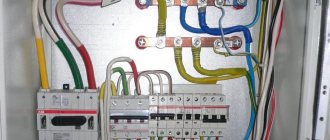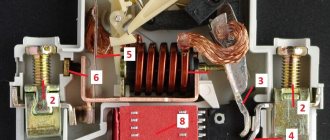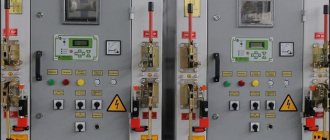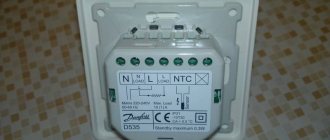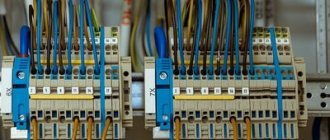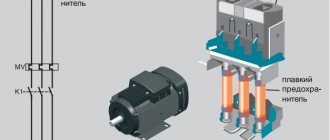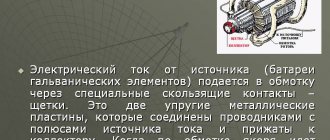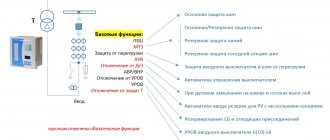Identification of damaged components in electrical networks and systems is carried out using protection. Such protection has a selective effect. Thanks to this feature, reliable and long-term operation of electrical equipment is possible, as well as the safety of its maintenance by technical personnel.
Selectivity
Main tasks of selective protection
Selectivity is a process that means selection (selection). This term is applicable to different industries and areas of human activity. For example, in chemistry, when chemical reactions occur, they talk about the selectivity index. In this case, the selectivity of chemical transformations is considered.
As for a person, his perception of the world around him, the choice of information, as well as its memorization are selective.
What is selectivity in electrical engineering, and why is it needed?
The tasks of electrical selective protection include:
- guaranteeing the safety of equipment and operating personnel;
- instantly identifying the location of the fault and disconnecting only the faulty section;
- reducing the negative effects of the accident on other components and parts of electrical appliances;
- minimizing damage to the faulty area;
- guaranteeing maximum continuity of operation of the electrical system;
- achieving ease of operation of electrical equipment.
In addition, selectivity reduces the consequences of short circuits and the load on the device.
Main functions
The key objectives of selective protection are to ensure the uninterrupted functioning of the electrical system and prevent mechanisms from burning out when threats arise. The only condition for the correct operation of this type of protection is the consistency of the protective units with each other.
As soon as an emergency occurs, the damaged area is instantly identified and switched off using selective protection. At the same time, the working places continue to work, and the disabled ones do not interfere with them in any way. Selectivity significantly reduces the load on electrical installations.
The basic principle of arranging this type of protection lies in the equipment of circuit breakers with a rated current that is less than that of the device at the input. In total, they can exceed the nominal value of the group machine, but individually - never. For example, when installing a 50 A input device, the next device should not have a rating higher than 40 A. The unit located as close as possible to the emergency site will always operate first.
NOTE! The choice of circuit breakers, including those for protection with absolute selectivity, depends on their rating and response characteristics, which are designated B, C and D. Often, various types of circuit breakers, fuses, and RCDs serve as devices that protect the electrical system.
Thus, the main functions of selective protection include:
- ensuring the safety of electrical devices and workers;
- quick identification and shutdown of the area of the electrical system where the breakdown occurred (at the same time, the working areas do not stop functioning);
- reduction of negative consequences for the working parts of electrical mechanisms;
- reducing the load on component mechanisms, preventing breakdowns in the faulty area;
- guarantee of continuous work process and constant high-level power supply.
- support for optimal operation of a particular installation.
Absolute and relative selectivity of protection
Considering in detail what selectivity is, there are two types of selective action.
Features of differential protection of power equipment
According to the degree of selectivity, protection is divided into:
- absolute;
- relative.
The blowing of fuses in the exact circuit where the short circuit occurred is called “absolute protection”.
The tripping of a circuit breaker close to where the fuse failed is called "relative protection".
Attention! We can say that absolute selective protection protects against internal (own) short circuits, and relative selective protection protects against external (neighboring) and internal short circuits at the same time.
Relative and absolute selectivity of protection
Conclusion
Often, current or time selectivity is used in household electrical networks. The optimal way for this is to install a RCD in series, when there is one common switch and several more are located on the loop. Selective protection contributes to the correct and uninterrupted operation of equipment.
Sources
- https://orenburgelectro.ru/drugoe/chto-takoe-selektivnost-v-elektrike-sovety-elektrika.html
- https://grand-electro.ru/elektrooborudovanie/chto-oznachaet-selektivnost-v-elektrike-vidy-selektivnoy-zaschity.html
- https://ectrl.ru/montazh/selektivnost-eto.html
- https://amperof.ru/teoriya/selektivnost.html
- https://rusenergetics.ru/polezno-znat/selektivnost-avtomaticheskikh-vyklyuchateley
- https://odinelectric.ru/knowledgebase/chto-takoe-selectivnost-v-electrike
- https://tokzamer.ru/novosti/selektivnost-avtomaticheskih-vykljuchatelej-pue
- https://SamElectric.ru/spravka/selektivnost-na-modulnyh-avtomatah-kak-dostich-nevozmozhnogo.html
- https://electricremont.ru/chto-takoe-selektivnost-v-elektrike.html
- https://www.21vek-220v.ru/articles/chto-takoe-selektivnost-avtomaticheskix-vyklyuchatelej
- https://NpfGeoProm.ru/teoriya-i-opyt/selektivnost-avtomaticheskih-vyklyuchatelej-pue.html
- https://oncool.ru/vyklyuchateli/selektivnost-avtomaticheskogo-vyklyuchatelya-pue.html
Types of selective connection schemes
Protective equipment is divided into several types based on selectivity. These include the following types of protection:
- full;
- partial;
- current;
- temporary;
- time-current;
- energy.
Overcurrent protection
Each of them needs to be discussed separately.
Full and partial protection
With such circuit protection, the devices are connected in series. In the event of an overcurrent, the circuit breaker that is closest to the fault will operate.
Important! Partial selective protection differs from full selectivity in that it operates only up to the set overcurrent value.
Current selectivity type
By arranging the magnitudes of currents from source to load in descending order, current selectivity is ensured. The main measure here is the limiting value of the current tag.
For example, starting from the power source or input, circuit breakers are installed in the sequence: 25A, 16A, 10A. All machines can have the same response time.
Important! There must be a high circuit resistance between the machines. Then they will have effective selectivity. They increase resistance by increasing the length of the line, including sections with a wire of smaller diameter or inserting a transformer winding.
Current selectivity
Time and time-current selectivity
What does time selective protection mean? A feature of this design of a relay protection circuit is that it is tied to the response time of each protective element. Automatic switches have the same current parameters, but have different time delays when triggered. The response time increases as you move away from the load. For example, the closest one is designed to operate after 0.2 s. If it fails after 0.5 s. the second one should work. The operation of the third circuit breaker is calculated after 1 second in case of failure of the first two.
Temporal selectivity
Time-current selectivity is considered very difficult. To organize it, you need to select devices from groups: A, B, C, D. Group A has the highest protection (used in electrical circuits). Each of these groups has an individual response to the magnitude of the electric current and the time delay.
Energy selectivity of machines
This protection is due to the properties of the switches provided by the manufacturer. Fast response - before short-circuit currents reach their maximum. Milliseconds count; it is very difficult to coordinate such selectivity.
Energy selectivity
What is zone selectivity
The determination of this coverage by selective network protection is related to the peculiarities of its construction. This is a rather expensive and complicated method. As a result of processing the signals coming from each switch, the fault zone is determined, and shutdown occurs only in it.
Information. To provide such protection, additional power is required. The signal from each switch is sent to the control center. Shutdowns are made by electronic releases.
It is most rational to use such circuits in industrial enterprises, where systems have high values of short-circuit currents and significant operating currents.
Example and graph of zone selectivity
Provision methods
As for the overload zone, only one type of selectivity is used here - time-current. In the short circuit zone there may be more types of selectivity.
The time-current characteristic determines the operation of two switches installed in series, in which the response time of the first one, standing on the load, is faster than the second, standing on the power supply.
Attention! The greater the current during an overload, the faster the protective device operates.
Therefore, when choosing circuit breakers for the electrical network, it is necessary to take into account their thresholds: by time and by current strength (nominal). In this case, the switch on the load side should always operate faster than the switch (selective RCD) on the supply side.
Current selectivity is based on the magnitude of the detected voltage. It is known that the closer to the source of the short circuit, the greater the overcurrent in this area, and, therefore, the higher the voltage. By installing circuit breakers in sections, you can easily determine which of them has a short circuit.
Time selectivity is a qualitative continuation of current selectivity. Current protection is also defined here, but a time range is also added. In this case, the protective device does not operate immediately in the event of a short circuit, but only after a certain delay time. Why is this necessary? The goal is to enable protective devices in adjacent areas to operate in order to isolate the short-circuit area from them.
Energy selectivity is specific. It is characterized by current-limiting indicators. Therefore, in electrical networks, so-called molded case circuit breakers are used, in which the tripping time is determined by thousandths of a second. That is, they operate so quickly that the short circuit current does not have time to reach its maximum value.
Zone selectivity works on the principle of dialogue between current measuring devices, which, upon detecting a threshold for exceeding current parameters, immediately turn off the fault zone. The most important thing is that the protective device accurately determines the shutdown zone. Essentially, this is time selectivity, only with a faster network shutdown.
What are double pole circuit breakers used for?
Many people believe that automatic switches with two poles are completely unnecessary, since a single-pole circuit breaker installed on a phase wire turns off and de-energizes the entire system. But such an installation does not guarantee complete safety of the system after disconnection, since currents in the neutral may be present after disconnection of one of the phase wires. To avoid such situations, you need to install automatic two-pole circuit breakers in a two-wire circuit that disconnect both wires at once. Modular two-pole circuit breakers are installed on a standard DIN rail and take the place of two single-pole devices (36 mm). The characteristics of two-pole circuit breakers can have all the options: B, C, D. The applicability of two-pole circuit breakers is not as wide as single-pole or three-pole ones, but they are still used in construction and industrial needs. In apartments and houses, a two-pole circuit breaker cannot be replaced as an input circuit breaker, especially in old housing stock, where all wiring has only two wires. When such a machine is turned off, we can speak with complete confidence about the safety of any repairs and maintenance work on the apartment’s electrical systems. But, no matter what, the number of installed double-pole circuit breakers is always less than single-pole circuit breakers. Typically, the number of single-pole ones is three times higher than the number of double-pole ones. In addition to the described use of a two-pole circuit breaker as an input for a two-wire network, it can be used as a control and protective element for systems with technological (mechanical, kinematic and other) communication. That is, when one device is turned off due to a malfunction, another device must be turned off, which cannot work when the first one is stopped. Moreover, these devices can be powered via two independent lines, but they can be turned off simultaneously. This property of a two-pole circuit breaker is used extremely rarely. An example of using a two-pole circuit breaker to automate a system is connecting an electric heating boiler and circulation pump. In this case, the powerful heating element of the boiler is powered through one pole of the machine, and the pump with significantly less power through the other. If the heating element of the boiler malfunctions, two devices will turn off at once. But a particularly important case will be a pump malfunction, which will turn off the heating element and prevent the boiler from overheating if there is no water circulation in the system. back
What are double pole circuit breakers used for?
Many people believe that automatic switches with two poles are completely unnecessary, since a single-pole circuit breaker installed on a phase wire turns off and de-energizes the entire system. But such an installation does not guarantee complete safety of the system after disconnection, since currents in the neutral may be present after disconnection of one of the phase wires. To avoid such situations, you need to install automatic two-pole circuit breakers in a two-wire circuit that disconnect both wires at once. Modular two-pole circuit breakers are installed on a standard DIN rail and take the place of two single-pole devices (36 mm). The characteristics of two-pole circuit breakers can have all the options: B, C, D. The applicability of two-pole circuit breakers is not as wide as single-pole or three-pole ones, but they are still used in construction and industrial needs. In apartments and houses, a two-pole circuit breaker cannot be replaced as an input circuit breaker, especially in old housing stock, where all wiring has only two wires. When such a machine is turned off, we can speak with complete confidence about the safety of any repairs and maintenance work on the apartment’s electrical systems. But, no matter what, the number of installed double-pole circuit breakers is always less than single-pole circuit breakers. Typically, the number of single-pole ones is three times higher than the number of double-pole ones. In addition to the described use of a two-pole circuit breaker as an input for a two-wire network, it can be used as a control and protective element for systems with technological (mechanical, kinematic and other) communication. That is, when one device is turned off due to a malfunction, another device must be turned off, which cannot work when the first one is stopped. Moreover, these devices can be powered via two independent lines, but they can be turned off simultaneously. This property of a two-pole circuit breaker is used extremely rarely. An example of using a two-pole circuit breaker to automate a system is connecting an electric heating boiler and circulation pump. In this case, the powerful heating element of the boiler is powered through one pole of the machine, and the pump with significantly less power through the other. If the heating element of the boiler malfunctions, two devices will turn off at once. But a particularly important case will be a pump malfunction, which will turn off the heating element and prevent the boiler from overheating if there is no water circulation in the system. 01/2/2015
Installation and selection of a circuit breaker must take into account the requirement of selectivity. The selectivity of circuit breakers is the selection of devices in one system in such a way that in the event of damage or an emergency in any part of the electrical system, the shutdown is carried out by one circuit breaker, which is located closest to the location of the fault on the line and other circuit breakers do not operate. That is, if a malfunction or accident occurs in the area of the socket, then only the circuit breaker of the socket group of this room is turned off, and the machines located between the meter and this machine are not turned off. There are several options for selectivity. Full selectivity is the option for selecting and installing circuit breakers, which, in the event of any damage, turns off the circuit breaker farthest from the input circuit, while the rest remain on. Partial selectivity is the option of selecting and installing circuit breakers with the condition that in the event of a malfunction, the distant circuit breaker is switched off at lower values of the short circuit current, and at the full value of the short circuit current, the condition may not be met. Lack of selectivity is an option for installing machines in such a way that several machines are switched off simultaneously.
Calculation of selectivity of machines
When considering the question of what selectivity is, it is necessary to have an idea of how it is calculated. Calculations come down to the correct selection of a protective device, in particular an automatic machine.
Selectivity for machines located close to the power source must satisfy the following condition:
Is.o.last ≥ Kn.o.* Ik. previous,
Here:
- Is.o.last – the value of the current that triggers the protection;
- Kn.o. – shutdown reliability coefficient;
- I part previous – short-circuit current at the end of the protection section.
In the case of time dependence, the following formula is used to calculate selectivity:
Ts.o.last ≥ Tk.prev.+ ∆T,
Where:
- Tс.о.last and Тк.prev. – time intervals through which cut-off switches operate;
- ∆T – selectivity time point.
The selection of automatic switches for calculations is carried out according to the tables.
Machine selectivity table
Principle of logic
To implement circuits using this principle, digital relays are needed. The relays are connected to each other by a twisted pair line, a fiber optic cable, or via a telephone line (using a modem). With the help of such lines, information is received (transmitted) to the dispatch console from different objects and between the relays themselves.
The principle of logic in a radial network
The given Picture 9 explains the principle of operation of the logic. Each of the 4 digital relays uses a current setting equal to the most recent sensitive stage. This stage has an operating time of 0.2 s. Logical selectivity implies the possibility of blocking the relay with a LO (logical standby) signal. This signal is supplied through the channel from the previous protection relay. Each of the relays can transmit such signals in transit.
As can be seen from the figure, during a short circuit at point K1, all other relays, from the LO signal supplied by relay K1, will be on hold. Relay K1 will operate and shut down. In the event of a short circuit at point 2, relay K4 will operate in the same way.
Such schemes for constructing logical control are demanding on the reliability of communication lines between elements.
Directional principle
The arrangement of the machines and the further sequence of their operation are guided by the direction of the current. To do this, using the voltage vector, a point is specified, relative to which this vector receives a phase shift. According to this principle, the relay will be sensitive to both current and voltage. Such a circuit can be installed in both a switchable zone and a zone that cannot be switched off.
RCDs and switches are connected according to the directional principle
Important! To implement such circuits, voltage transformers are needed to use them to determine the direction of the current.
In the above figure, you can see that the protective device D1 and the circuit breaker it controls will respond to a short circuit at point 1, but not to a short circuit at point 2.
Principle of differentiation
It is used where circuits with high power consumers are used. These consumers include:
- electric motors and generators;
- power cables;
- bus assemblies;
- transformers and other converters.
In this solution, deviations of the phase and amplitude parameters of the current at various points are used. A deviation of such values at point A and point B, in section AB, is considered an emergency, and the equipment shuts down. The use of current transformers allows filtering from various extraneous electromagnetic processes.
The protection is triggered only in the AB section if IA>IB.
Differential selective protection of powerful equipment
Protection created according to the differential principle can be of two types: longitudinal and transverse.
Selectivity map and rules for its creation
The diagram of the approved sample, on which all current parameters of protective devices and devices are plotted, indicating the common power source, is carried out on a scale convenient for viewing. This is a selectivity map. It ensures maximum use of the protective qualities of circuit breakers. All processes possible during operation are displayed graphically.
The following must be included on the map:
- places of important calculation points;
- protective characteristics of automatic circuit breakers and possible short circuits, while their min and max values are indicated.
This map serves as the basis for compiling a table for the selection of protective devices. In addition, the map allows you to evaluate the overall protective selectivity and provides complete information about the mutually agreed upon settings of all machines.
The map is constructed along axes. The abscissa axis represents current values, and the ordinate axis represents time values.
For your information. Other types of characteristics can be applied to the axis. Each scheme includes the parameters of two or three machines. The construction of such maps can be done using a computer program.
An example of a selectivity map made using the program
Properly executed selective protection allows you to preserve equipment. When a specific section is turned off, it allows you to turn the power back on using an automatic transfer switch (ATS) and minimize equipment downtime and interruptions in the supply of electricity to consumers.
What it is?
First of all, the concept of “selectivity” includes a protective mechanism and well-functioning operation of certain devices consisting of individual elements connected in series to each other. Often, such devices are various types of automatic circuit breakers, fuses, RCDs, etc. The result of their work is to prevent the “burning out” of electrical mechanisms in the event of threats. A diagram of the selective operation of circuit breakers and RCDs in the panel is provided below:
The advantage of this system is its ability to turn off only the necessary areas, while the rest of the system remains in working order. The only condition for this remains the consistency of the protective devices with each other.
